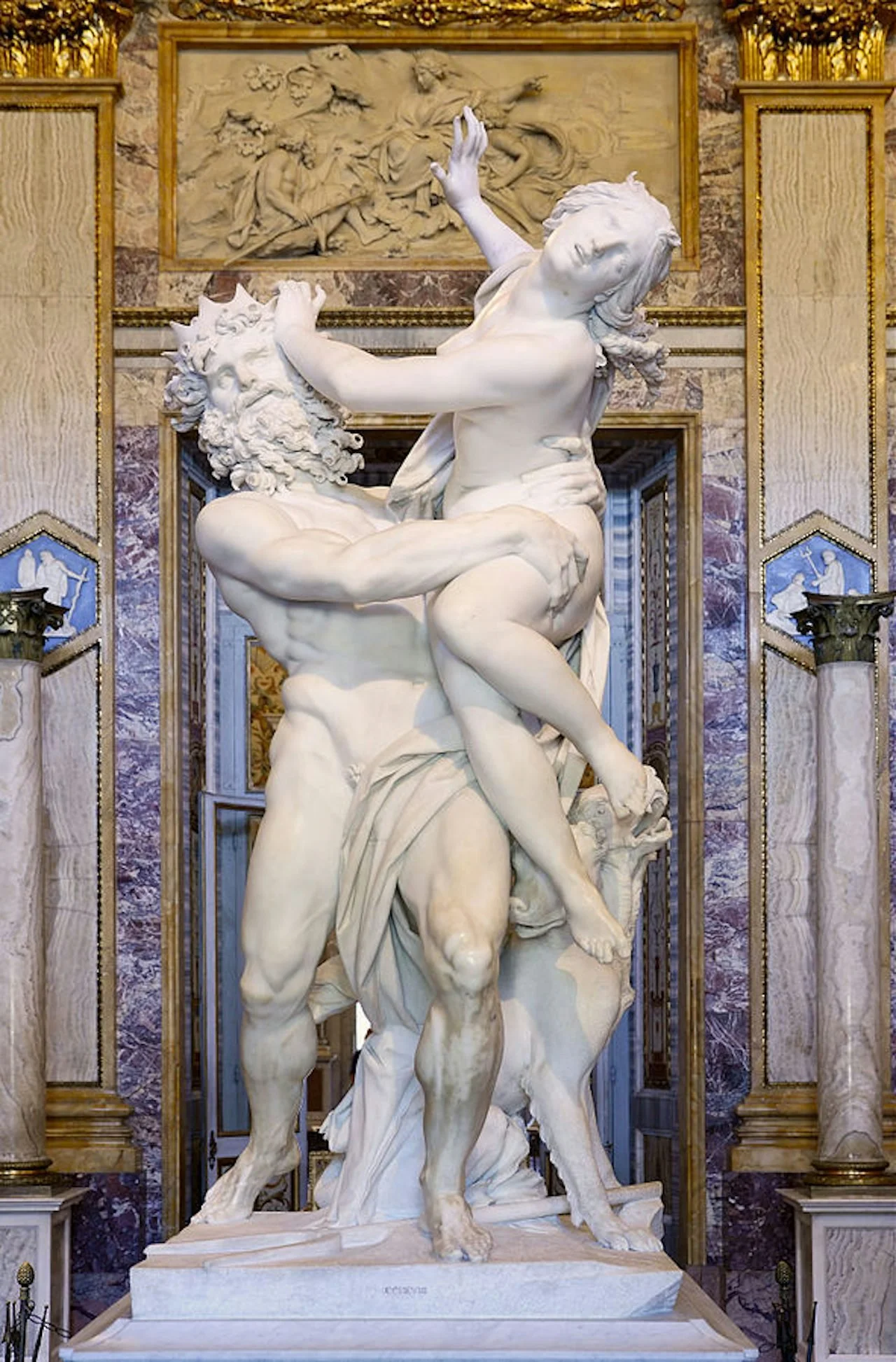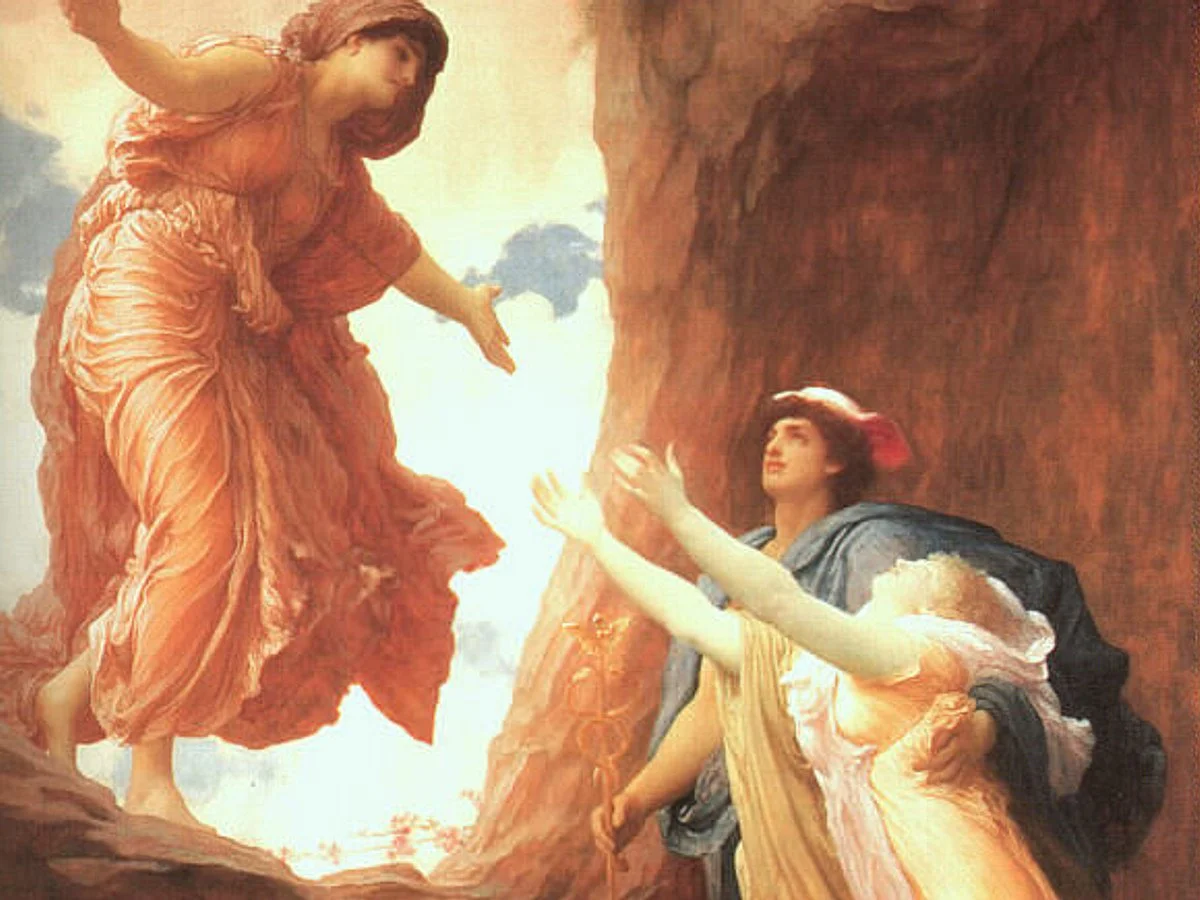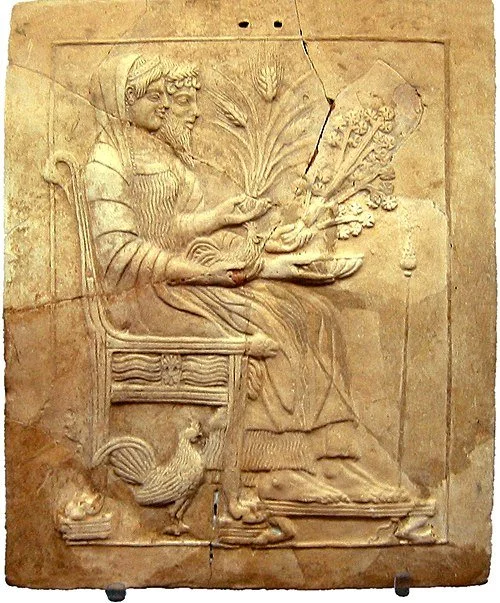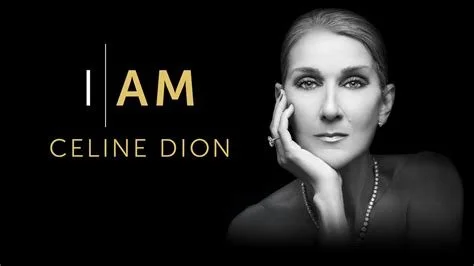Aries II: Persephone
Welcome to the second post of my Deities and Decans series! Today we’ll be looking at Persephone, who is the deity associated with the Aries II decan. This is also the decan holding the Sun’s exaltation degree (19°), which I think is very important to note, as we look into the myth and symbolism of Persephone. I have to admit, I had to spend a lot more time with Persephone before starting to write about her than I initially expected. It might have to do with the fact that my Sun is in his fall in Libra II, but I’m glad I got to meditate on Persephone’s role in both mythology, and as the deity ascribed to this decan. Let’s dive in!
The Maiden’s Tale
The Rape of Proserpine by Gian Lorenzo Bernini (1621/1622). Borghese Gallery, Rome, Italy.
Persephone (Persephonē, Proserpina) was the daughter of Zeus and Demeter, who was abducted by her uncle — and future husband — Hades. One day while she was picking flowers, Hades emerged from the Underworld in his chariot, and took her to be Queen of the Underworld. Before the two plunged back into the world of Hades, Hecate heard Persephone’s cries and Helios saw the event take place, which is how Demeter eventually ended up figuring out where she was.
Demeter was furious with the fact that her daughter was abducted, and also that Zeus essentially gave his blessing to Hades without telling her. She “avoided the gathering of the gods and high Olympus, and went to the towns and rich fields of men, disfiguring her form a long while” (Homer, line 90-91). Demeter wandered until she reached Eleusis, a town in the region of Attica, just northwest of Athens. There she was well-received by the King Celeus and Queen Metaneira and in return, tried to heal their sick son by nursing him… and making him immortal. This attempt to make the Prince immortal failed once the Queen saw Demeter holding her son in the fire.
Once everyone found out that this strange old woman was actually a goddess, Demeter ordered the people of Eleusis to build a temple in her honour, and promptly abandoned her responsibilities as goddess of agriculture. As a result, crops ceased to grow and famine started to mount; if it wasn’t for Zeus (finally) intervening it would’ve been possible for her to starve all mortals. Zeus ensured the mother and daughter would be reunited, however there was a catch.
Frederic Leighton, The Return of Persephone, 1891.
The joy of Demeter and Persephone reuniting was met with a harsh reality: Persephone had bound herself to the Underworld by eating some pomegranate seeds. Though this was a sneaky trick by Hades, Zeus obliges his brother, and Persephone must split-up her time between being with Demeter and Hades during the course of the year. This is said to have been the reason for us have 4 seasons, as Persephone is with Demeter during spring and summer, and then goes to the Underworld in fall and winter. The blooms are connected to the reunion of mother and daughter, and the Sun fading during the fall equinox is when Demeter must let her daughter lead her second life.
The Duality of Persephone
Now that we know the myth of Persephone, it’s time to take a look at who she is. With her being the daughter of Demeter, and even being worshipped in the same temples alongside her mother, it can be quite difficult to see her as she herself is. Even when looking her up online or in texts, she is often referred to through her association with Demeter, or like we saw with the myth of her abduction, it is featured in Homer’s Hymn to Demeter, which is quite telling of both their mother-daughter relationship, and of what Persephone symbolizes on a mythical level. In a way, it seems like Demeter’s story is Persephone’s story and vice-versa; a never-ending dance that is both full of love and pain.
Pinax of Persephone and Hades from Epizephyrian Locris. Reggio Calabria, National Museum of Magna Graecia.
Though Persephone is Hades’s wife in the Underworld, it is in this context that we can see a bit more of Persephone’s independence come through. She was of course feared by mortals just like her husband, but she would nonetheless listen and grant requests from the souls that entered through the Gates of Hades, like when she allowed Orpheus to bring Eurydice back with him under the condition that he didn’t look back at her. In certain recounts when Theseus and Pirithous tried to abduct her, Persephone still lets Hercules bring the guilty parties back with him. All of these examples show us that Persephone’s true character tends to come out while she’s in this role of Queen of the Underworld, and despite her harsh and powerful exterior, her soft side still peaks through. An ode to where she came from, in a sense.
The duality of Persephone extends outside the home/family dynamic as well, and into her romantic affairs. It is said that she had her eyes set on Aphrodite’s mortal lover Adonis, and that in the end Adonis had to divide his time equally between both goddesses to appease their tempers (Kerényi, 1951). Once again we’re seeing that theme of twos showing up in myths attached to Persephone. There’s even an alternative myth making Rhea and Zeus Persephone’s parents as opposed to Zeus and Demeter. It seems as though any aspect of girlhood/womanhood of Persephone’s story always comes with a splitting into two; embodying two different roles simultaneously.
The Sun, the Seasons and Womanhood
The Spring Witch by George Wilson (1880).
The cycle of going between both worlds, can be see through the seasonal shifts. This means that Persephone’s movement across the Gates of Hades lines up with the spring and fall equinox, and therefore possesses a solar quality. When the Earth is blooming and the days increase in light, Persephone reunites with her mother, lining up with the most fertile and warmest months of the year. This portion of the year tends to represent the first half of life, youth and girlhood, mirroring Persephone’s reunion with her mother; the Queen of the Underworld suddenly becomes the Maiden and Demeter’s daughter once again.
The shift into fall, symbolizes Persephone’s descent back into the Underworld. Not only marking the start of shorter days, but also serving as a reminder of the separation of Demeter and he beloved daughter. It’s far colder and gloomy during this time of year, meaning to represent the sadness that Demeter carries when her daughter is gone. Though Persephone exists as her own person in the Underworld, her mother will continue to grieve above ground, until her return; marking the season of bare fields and low crop yield. This portion of the year tends to be associated with the second half of life; the more serious part where Persephone steps into her role as Hades’s Queen.
The life/death/rebirth cycle is ever-present in the myth of Persephone. Ruling over all things womanhood, female initiation, and fertility, it’s easy to notice that all of these topics have a cyclical nature to them as well. We have the cyclical nature of the woman herself, but then we also must consider things like the hormonal cycle, the menstrual cycle, and pregnancy. Though these are things often associated with the Moon, Persephone may offer a more “solar” perspective on these matters; in so far as Persephone is meant to highlight the resilience and compromise through these pivotal moments.
Persephone didn’t voluntarily go with Hades — far from it — but she assumed her chthonic role and was quite good at it to boot. She couldn’t spend every waking moment with her mother anymore, but always visited her and could effortlessly come back into her role as daughter. When she wanted affection from a lover, instead of backing down from the ruthless and possessive Aphrodite, she held her ground and still got Adonis all to herself for half of the year. You can say what you want about Persephone, but you cannot tell me she doesn’t have range, and isn’t a force to be reckoned with!
Celine Dion’s Crown
With Aries II being a double Sun ruled decan, I wanted to find a chart example that really captured the solar essence of this decan. Fortunately enough, the iconic French-canadian singer Céline Dion has her Sun (chart ruler), Saturn, Midheaven and North Node all in Aries II.
Céline Dion’s natal chart
Austin Coppock named this decan “The Crown,” giving this face a royal air, which is quite accurate when considering the more potent Solar influence found in Aries II. The Sun in astrology speaks to the self, making this decan one of self-actualization if the native shows up and puts in the effort. This decan is one where natives really “shine” and this definitely rings true for Céline!
Céline Dion, 2012
Dion was discovered in her teens by her future manager and husband, and went on to have the most success career of any Canadian musician to date. Being named “the Queen of Ballads” it’s safe to say that Céline has made a name for herself over the years, capturing the hearts of many worldwide with her unique and memorable voice. One of her most well known songs “Ne partez pas sans moi” sung for Switzerland in the 1988 Eurovision competition, is a song that literally every francophone knows or has at least heard once in their life. You can definitely say that Céline Dion’s music is a very important part of francophone culture across the globe, as she also holds the title of best-selling French artist.
We can see that Persephone’s theme of duality come through for Céline, as she is bilingual both on a personal and professional level. She is extremely well-known both in her home country and abroad, making her an international sensation that can cross cultural lines. The duality goes so far, that Dion actually alternates her releases by language, always making sure to do a French album, followed by an English one; and they’re always a hit with her fans.
Dion had such great success that she was appointed to Companions of the Order of Canada, which is “the highest level of the Order of Canada, [having] demonstrated the highest degree of merit to Canada and humanity, on the national or international scene. Up to 15 companions are appointed each year, with a limit of 180 living companions at any given time” (Wikipedia). This shows us just how much dedication and skill Céline has, as this is a very exclusive group of Canadians who obtain this level of merit; once again pointing to the power that comes with this decan.
Unfortunately though, with Aries II comes hardship, and Céline’s case is no different. She grew up rather poor, and was unfortunately victim to many accidents in her childhood. She started singing at 5 years old, and was famous by the time she was 13. Even if this changed with her rise to fame in her childhood, it came at the price of her youth. In an interview, Dion said “she doesn’t regret this because she doesn’t know what she missed” (Cheetsheet), which echoes the notion of resilience amidst transition that we see with the myths of Persephone. Though no child wants to skip over their youth, Céline made the best of an unideal situation, and ultimately came out on top.
Céline and René, 2012
Her relationship with to René Angélil was also quite a scandalous topic, as her husband and her met when they were 38 and 12 respectively. René and Céline took a professional break from each other after he ended his second marriage, as both knew that they caught feelings and it was looked upon poorly. When Dion was 25 however, the couple got engaged, and married a year later. With her husband also being her first manager, I cannot imagine the pressures that came with this dynamic, as both parties were fulfilling multiple roles while knowing each other, and these roles would drastically change over time. Despite everything, they somehow made it work until René passed away in 2016. With her 7H being ruled by her Aries II Saturn, it’s interesting to see how controversial, yet successful her marriage to René ended up being.
Dion also had a lot of complications around pregnancy, and openly disclosed that she had fertility issues. Instead of giving up however, Dion was dedicated to ameliorating her chances of conceiving as best as she could, and had her first child in 2001after reproductive surgery. Her fertility problems didn’t stop there though, as she continued having trouble conceiving, and even had a miscarriage in 2009. In 2010 she announced that she was pregnant with twins after multiple rounds of IVF, and carried the pregnancy to term without major complications. Though these topics aren’t easy to navigate in the slightest, Céline remained open and unashamed of her trials, sharing her experiences and inspiring people everywhere.
Poster for “I AM CELINE DION” documentary, 2024
More recently in 2022 it came out that Céline Dion was diagnosed with stiff-person syndrome, which is a neurological disorder affecting her muscles. This came after 17 years of symptoms that posed a problem for Dion’s health, as well as her career, as she couldn’t perform for nearly two years post-diagnosis. Instead of hiding in the shadows, Céline held her head up high and released her documentary “I am Celine Dion” where she discussed her life and career, along with her battle with stiff-person syndrome. With the help of her doctors, family and loved one’s, Céline managed to come back stronger than ever, performing at the 2024 Summer Olympics in Paris where she took part of the opening ceremonies. Her fans were overjoyed to see Céline doing what she loves most in the world, while looking happy and healthy on top of the Eiffel Tower.
Just like Persephone, Céline Dion assumed ever role she was given with grace, power, and immense courage. Even when the odds were stacked against her, she never faltered and always did everything she could to better her odds, often surpassing expectations. Heavy is the head that wears the crown, but for these two it merely seems like second nature.
Citations
36 Faces, Austin Coppock. Three Hands Press. 2014. 36 Faces, Austin Coppock. Three Hands Press. 2014.
Homer. Hymn to Demeter. Translated by Hugh Evelyn-White. Loeb Classical Library, https://www.sacred-texts.com/cla/demeter.htm.
Kerényi, Károly. The Gods of the Greeks. London: Thames and Hudson, 1951.
“Celine Dion.” Wikipedia, Wikimedia Foundation, 4 Oct. 2025, en.wikipedia.org/wiki/Celine_Dion#.
“List of Companions of the Order of Canada.” Wikipedia, Wikimedia Foundation, 4 Sept. 2025, en.wikipedia.org/wiki/List_of_companions_of_the_Order_of_Canada.







